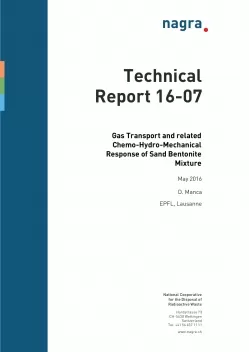
Technical Report NTB 16-07
Gas Transport and related Chemo-Hydro-Mechanical Response of Sand Bentonite Mixture
In Switzerland, the Nuclear Energy Law requires the disposal of all types of radioactive waste in deep geological repositories. The Swiss Radioactive Waste Management Programme foresees two types of deep geological repositories: a high-level waste repository (HLW repository) for spent fuel (SF), vitrified high-level waste (HLW) and long-lived intermediate-level waste (ILW), and a repository for low- and intermediate-level waste (L/ILW repository). The Opalinus Clay has been proposed as the preferred host rock formation for both repository types, and a depth range between 300 and 700 m below the ground surface has been specified as favourable repository level for L/ILW (Nagra 2014).
The layout of the L/ILW repository is based on a multi-barrier concept, comprising a system of engineered barriers (EBS) and the geological barriers. The materials used for the construction of the EBS components have to ensure the performance of their designated long-term safety functions (physical isolation of the wastes; long-term stability; confinement, retarded release and retention of radionuclides). Sand/bentonite (S/B) mixtures at low bentonite content (i.e. 20 to 30 % of bentonite) are considered as appropriate sealing and backfilling materials for the underground structures, forming the main component of the so-called "Engineered Gas Transport System" (EGTS) of the L/ILW repository (Nagra 2008a). In this context, the EGTS is aimed at increasing the gas transport capacity of the backfilled underground structures without compromising the radionuclide retention capacity of the EBS.
Understanding and quantifying the hydro-mechanical and -chemical (HMC) phenomena governing water and gas transport through an 80/20 S/B mixture is crucial for ensuring the safety of the L/ILW repository at both short and long term. This research has been dedicated to a comprehensive experimental characterisation of the S/B mixtures at macroscopic and microscopic level, following a well-established soil-mechanical workflow.
At macroscopic level, free and confined swelling tests are performed on specimens compacted to different dry densities and wetted with pore fluids of different chemical composition. Controlled suction confined swelling tests are carried out for determining the water retention curve, as well as the suction-swelling pressure relationship for two different densities. The water retention capacity is determined for a wide suction range. The water permeability of the mixture is measured under full saturation conditions, for a wide range of densities and using different pore fluids. The relationship between the unsaturated water permeability and the degree of saturation is determined for two-target dry densities.
Gas injection tests on the mixture are performed in both saturated and unsaturated conditions. Two different experimental setups are adopted to investigate the influence of the method used for preparing the specimens, as well as how the boundary conditions affect the gas permeability and the breakthrough pressure. A highly advanced triaxial cell, equipped with a laser scanning system for measuring the radial deformations, allows analysing the volumetric response of the mixture during the gas injection.
The results reveal that the swelling pressure and the saturated hydraulic conductivity depend on the applied matric suction and on the pore water chemistry. In particular, at a low dry density, the mixture in contact with aqueous solutions loses most of its swelling capacity which causes strong increases of the saturated hydraulic conductivity. For a higher dry density, the swelling capacity of the mixture is better preserved and thus its hydraulic conductivity remains relatively low. Two distinct regions are identified in the water retention curve of the mixture: the first at a high suction, where the curve does not depend on the void ratio, and the second at a low suction, where the curve is significantly affected by it.
Finally, an extensive microstructural characterisation is performed using the mercury intrusion porosimetry and a high-resolution scanning electron microscope. This allows relating the observed HMC behaviour at the laboratory scale to the evolution of the different pore networks during a wetting – drying cycle. The transition from double to single structure is clearly detected upon wetting. This transition justifies the generation of the swelling pressure, as well as the significant reduction of the gas permeability upon wetting. A specific relation is proposed for determining at any HMC state the relative dry density of the bentonite as a function of bentonite content in the mixture. This enables the comparison of swelling data for other bentonite-based materials prepared at different mixing ratios. The microstructural analyses also allow the derivation of an expression for describing the geometrical permeability of the mixture upon different HMC loadings. Thanks to the proposed relation, it is possible to identify the contribution of the different pore families to water and gas transport through the active porous media.
